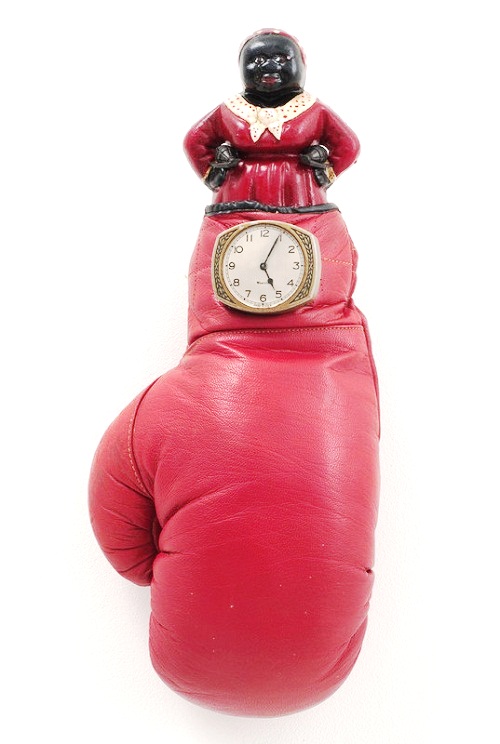 |
| Betye Saar. Image via ledgertranscript.com. |
Text | Amanda
Bastoni for Monadnock Ledger-Transcript
Published
| Wednesday, April 9, 2014
When Betye
Saar takes the podium to receive the Edward MacDowell Medal, she will be
88-years-old. As she accepts the award, Saar — who is famous for her artistic
assemblages challenging racial stereotypes and the role of African American
women — will become the 55th Medal recipient and coincidently a minority within
a minority.
On Aug.
10, Saar will be the oldest and only female African American woman to receive
the prestigious award.
“I don’t
mind being a minority,” Saar said. “It helps people see that old people, women
and people of color are not invisible,” she said speaking by phone from her
home in Los Angeles, Calif., on Wednesday.
Saar grew
up in Pasadena during the Great Depression, surrounded by creativity. Her
mother and grandmother painted ceramics, quilted and embroidered. Although
these were considered, “household” or “womens arts,” Saar said the “essence of
the creative process” was alive in her home.
After high
school, Saar earned a Bachelor of Arts degree from the University of California
at Los Angeles.
In 1949
after graduation, Saar began to work in costume design for California theater
companies, but her creative outlet shifted when she saw the work of Joseph
Cornell.
Cornell,
who was born in New York City in 1903 and died in 1972, pioneered the idea of
assemblage art. His most characteristic works were simple boxes that held
collections of photographs, magazine cut-outs, string and other ephemera or
knick-knacks.
Saar
attributes Cornell’s influence to helping her see that she had the power to use
what she found — everyday objects — to make political statements and fine art.
“I was a
kid who loved to collect things,” she explained. “As an artist I often call
myself a recycle — not just the recycling physical things, window frames and statues,
but also ideas and memories. Things that have value to me as an artist.”
In the
late 1960s, Saar began to acquire “black collectibles,” objects that feature
racist caricatures of African Americans.
Shortly
thereafter she created her own series of assemblages: “The Liberation of Aunt
Jemima.” Through these pieces Saar worked to turn negative “mammy” images into
positive, empowering symbols for African American women.
“The
Liberation of Aunt Jemima,” Saar said, “helped me focus on being a woman warrior
for civil rights and my weapon was art.”
Saar said
her art typically has three components: political, ritual and personal. Her
series “Workers and Warriors and In Service” reflect the similar themes to “The
Liberation of Aunt Jemima,” themes of resisting racism and servitude by
creating woman warriors armed with brooms.
“In a way,
it’s all political though,” she said. “My work is meant to show that black
people had lives, that they went to parties and were human.”
Saar said
she is often inspired by materials. For example, she did a series using
washboards that was meant to be a statement on woman’s work. “I was trying to
show the irony in black people washing and ironing the sheets of the Ku Klux
Klan.”
Many of
her works are made with primitive materials such as wood, or found objects, and
in a style that evokes African American cultures as well as voodooism, said
Saar.
For this
reason, some of Saar’s art has been misunderstood. She has been called a “devil
worshiper” and has received some criticism for her use of derogatory images of
African Americans in her art. Saar believes that, as she put it, “You have to
know where you’ve been before you can know where you are going,” and she hopes
her artwork “makes people think.”
Her
ultimate goal, she said, is to show the similarity between people. “The bottom
line is we are all people. We are all earthlings. Despite our cultural
differences, we are people of the planet,” Saar said.
The timing
of the MacDowell Medal ceremony is particularly poignant for Saar as this July
marks the 50th anniversary of the Civil Rights Act being signed into law.
While
creating art, Saar and her husband, Richard, who was also an artist, were
raising their three daughters. Two of her daughters, Alison and Lezley, are
accomplished artists in their own right.
When asked
how she juggled the various roles of wife, artist and mother, Saar answered
with a hearty laugh: “There are always ways to sneak [your art] in.”
“Women can
be really creative in the kitchen — with spices and textures — or in how they
dress or in how you arrange your home.”
Saar
recommends that busy working women keep sketchbooks to collect their ideas for
later realization.
Saar is
looking forward to visiting the Northeast for the Medal Day ceremony. She will
come with her youngest daughter, Tracye, and her granddaughter. She hopes to
bring back home with her inspiration from New Hampshire, with visits to local
flea markets and antique shops.
Throughout
her career, Saar has received numerous awards, including two National Endowment
for the Arts Fellowships, as well as a J. Paul Getty Fund for the Visual Arts
Fellowship. Her work is represented in numerous museum collections, including
Los Angeles County Museum of Art, Museum of Fine Arts in Boston, the
Metropolitan Museum of Art and the Whitney Museum of American Art in New York.







